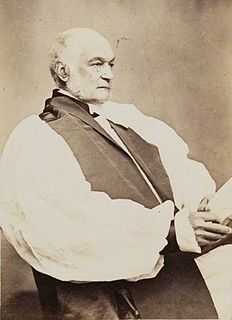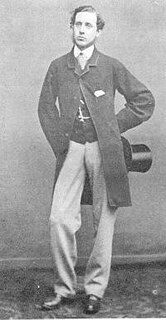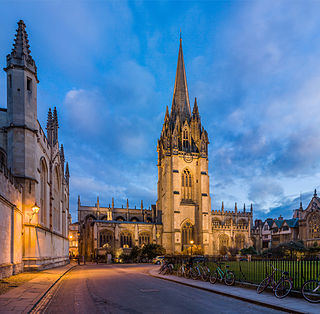Related Research Articles

The Immaculate Conception is the belief that the Virgin Mary was free of original sin from the moment of her conception. First debated by medieval theologians, it proved so controversial that it did not become part of official Catholic teaching until 1854, when Pius IX gave it the status of dogma in the papal bull Ineffabilis Deus.

Sir George Gilbert Scott, known as Sir Gilbert Scott, was a prolific English Gothic Revival architect, chiefly associated with the design, building and renovation of churches and cathedrals, although he started his career as a leading designer of workhouses. Over 800 buildings were designed or altered by him.

Eadburh was the daughter of King Edward the Elder of England and his third wife, Eadgifu of Kent. She lived most of her life as a nun known for her singing ability. Most of the information about her comes from hagiographies written several centuries after her life. She was canonised twelve years after her death and there are a small number of churches dedicated to her, most of which are located near Worcestershire, where she lived.

St Anne's College is a constituent college of the University of Oxford in England. It was founded in 1879 and gained full college status in 1959. Originally a women's college, it has admitted men since 1979. It has some 450 undergraduate and 200 graduate students and retains an original aim of allowing women of any financial background to study at Oxford. A recent count shows St Anne's accepting the highest proportion of female students of any college. The college stands between Woodstock and Banbury roads, next to the University Parks. In April 2017, Helen King, a retired Metropolitan Police Assistant Commissioner, took over as Principal from Tim Gardam. Former members include Amanda Pritchard, Danny Alexander, Ruth Deech, Helen Fielding, Martha Kearney, Simon Rattle, Tina Brown, Mr Hudson, and Victor Ubogu.

Thomas Howard, 3rd Duke of Norfolk, was a prominent English politician and nobleman of the Tudor era. He was an uncle of two of the wives of King Henry VIII, Anne Boleyn and Catherine Howard, both of whom were beheaded, and played a major role in the machinations affecting these royal marriages. After falling from favour in 1546, he was stripped of his Dukedom and imprisoned in the Tower of London, avoiding execution when Henry VIII died on 28 January 1547.

The House of Stuart, originally Stewart, was a royal house of Scotland, England, Ireland and later Great Britain. The family name comes from the office of High Steward of Scotland, which had been held by the family progenitor Walter fitz Alan. The name Stewart and variations had become established as a family name by the time of his grandson Walter Stewart. The first monarch of the Stewart line was Robert II, whose male-line descendants were kings and queens in Scotland from 1371, and of England and Great Britain from 1603, until 1714. Mary, Queen of Scots, was brought up in France where she adopted the French spelling of the name Stuart.

Cuthbert Tunstall was an English Scholastic, church leader, diplomat, administrator and royal adviser. He served as Prince-Bishop of Durham during the reigns of Henry VIII, Edward VI, Mary I and Elizabeth I.

John Moore was Archbishop of Canterbury in the Church of England.

St Mary Hall was a medieval academic hall of the University of Oxford. It was associated with Oriel College from 1326 to 1545, but functioned independently from 1545 until it was incorporated into Oriel College in 1902.

A rood or rood cross, sometimes known as a triumphal cross, is a cross or crucifix, especially the large crucifix set above the entrance to the chancel of a medieval church. Alternatively, it is a large sculpture or painting of the crucifixion of Jesus.

Birinus was the first Bishop of Dorchester and was known as the "Apostle to the West Saxons" for his conversion of the Kingdom of Wessex to Christianity. He is venerated as a saint by the Roman Catholic Church, the Eastern Orthodox Church, and Anglican churches.

Peter Mews was an English Royalist theologian and bishop. He was a captain captured at Naseby and he later had discussions in Scotland for the Royalist cause. Later made a Bishop he would report on non-conformist families.

George Moberly was an English cleric who was headmaster of Winchester College, and then served as Bishop of Salisbury from 1869 until his death.

William Herbert, 3rd Earl of Pembroke, of Wilton House in Wiltshire, was an English nobleman, politician and courtier. He served as Chancellor of the University of Oxford and together with King James I founded Pembroke College, Oxford. In 1608 he was appointed Warden of the Forest of Dean, Constable of St Briavels Castle, Gloucestershire, and in 1609 Governor of Portsmouth, all of which offices he retained until his death. He served as Lord Chamberlain from 1615 to 1625. In 1623 the First Folio of Shakespeare's plays was dedicated to him and his brother and successor Philip Herbert, 1st Earl of Montgomery.

Lady Jane Grey, later known as Lady Jane Dudley and as the "Nine Days' Queen", was a teenage English noblewoman who claimed the throne of England and Ireland from 10 July until 19 July 1553.

Charles Eamer Kempe was a Victorian era designer and manufacturer of stained glass. His studios produced over 4,000 windows and also designs for altars and altar frontals, furniture and furnishings, lichgates and memorials that helped to define a later nineteenth-century Anglican style. The list of English cathedrals containing examples of his work includes: Chester, Gloucester, Hereford, Lichfield, Wells, Winchester and York. Kempe's networks of patrons and influence stretched from the Royal Family and the Church of England hierarchy to the literary and artistic beau monde.

The University Church of St Mary the Virgin is an Oxford church situated on the north side of the High Street. It is the centre from which the University of Oxford grew and its parish consists almost exclusively of university and college buildings.

The Scottish Reformation was the process by which Scotland broke with the Papacy and developed a predominantly Calvinist national Kirk (church), which was strongly Presbyterian in its outlook. It was part of the wider European Protestant Reformation that took place from the sixteenth century.

Francis Turner D.D. was Bishop of Ely, one of the seven bishops who petitioned against the Declaration of Indulgence and one of the nine bishops who refused to take the oath of allegiance to William III.

Mary Wollstonecraft Shelley was an English novelist who wrote the Gothic novel Frankenstein; or, The Modern Prometheus (1818), which is considered an early example of science fiction. She also edited and promoted the works of her husband, the Romantic poet and philosopher Percy Bysshe Shelley. Her father was the political philosopher William Godwin and her mother was the philosopher and feminist activist Mary Wollstonecraft.
References
- ↑ CCEd
- ↑ Alumni Oxonienses 1500-1714, Riader-Roissie
- ↑ Horn, Joyce M. (1964), Fasti Ecclesiae Anglicanae 1300–1541, vol. 9, pp. 15–17